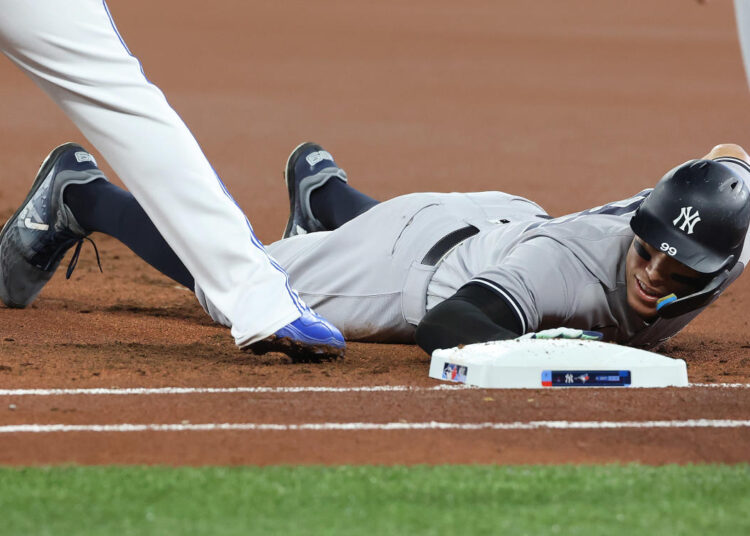After three years managing the Triple-A Durham Bulls — to a cumulative .589 record and consecutive Triple-A national championships in 2021 and ‘22 — Brady Williams is getting the call to the bigs this season. He’ll serve as the third-base coach for the famously savvy Tampa Bay Rays, with whom his knowledge of the organization’s up-and-coming players will serve him in deciding whether to send a guy.
He also brings valuable experience with some of the rule changes poised to go into effect at the major-league level this season. Williams has seen the bigger bases, nervously sweated through the pressure-packed pitch timer and even reckoned with robo-umps (which are at least a year away from infiltrating the majors). The intent of all this — along with limits on defensive positioning that were tested at lower levels — is to create a livelier game that packs more action into less time.
Williams has his own opinions about how effective the rules will be in actualizing that vision — he emailed the league to explain that umpires calling balls or strikes for clock infractions were bad for pace of play and to suggest a different penalty system — but understands that the game now is about adjusting to this new reality. And for that, he has some advice as teams prepare for a spring training that’ll be spent getting up to speed.
“For any coach, you have to coach better, honestly,” he told Yahoo Sports. “You gotta teach your players and hopefully get them more fundamentally sound with some things because the catcher and the pitcher can’t rely on the coach to call a pick-over.”
He was referring to a subsection of the pitch timer that could have even more strategic implications than the clock itself. When the timer was introduced on an experimental basis in the minor leagues, it became apparent that if pitchers could restart the clock by stepping off the rubber — to throw to first base, for instance — they would render the whole enterprise moot by doing so with abandon.
And so, along with governing the amount of time pitchers are allotted — in the majors this year, it will be 15 seconds between pitches with the bases empty and 20 seconds with runner(s) on — the rules also limit the number of times a pitcher can step off the rubber. Two “disengagements,” i.e. pick-off attempts, will be permitted per at-bat. If a third pick-off attempt is unsuccessful, the runner will be awarded second base.
In accordance with Williams’ advice, several major-league managers at the winter meetings in December mused that this rule in particular would require their attention as they rethink the running game and prepare pitchers to not be taken advantage of.
“It’s on us as managers,” Brewers skipper Craig Counsell said, “to help them manage it and be better in it. There’s probably a little more strategy involved in it.”
Counsell said the Brewers started talking to their pitchers this past season about how to hold runners without unlimited pickoffs in their arsenal. “Because it’s one of those things where it’s not important, it’s not important, and then we’re going to find out one day that it’s important.”
Pitching coaches talk about time to the plate, from coming set to delivering a pitch. Anything more than 1.4 seconds is a stolen base liability, but so is becoming too predictable in how long you hold the ball.
“You’ve still got to do all that stuff that we’ve been doing for 100 years,” said Rob Wooten, a pitching coach in the Cincinnati Reds’ system, at Double-A last year and Single-A this upcoming season. “But now there’s just some rules in place that can maybe make that a little bit more interesting.”
Stolen bases bounced back ever so slightly in the majors last season, but even so, teams were stealing just 0.51 bases per game, with a success rate right around 75%. In the minors, pick-off rules, bigger bases and the pitch timer itself — runners were “going off the clock,” as Williams put it, or getting a jump just before it ran out — combined to see teams steal 1.1 bases per game, at a 77% success rate.
In 2019, after Lucas Giolito transformed himself from one of the worst starters in the game into an ace, he explained some of what had been going wrong for him in 2018. “Every time a guy would get on first, he was pretty much standing on second,” he told NBC Sports Chicago. “I was slow to the plate, I wasn’t varying my times, I wasn’t varying my looks.”
Those skills — a swift but unpredictable delivery — will be all the more important for pitchers in an environment more conducive to running.
“It’s more changing your looks,” Williams said. “Talking about it daily with the pitcher, about how important it is to not rush but make sure you’re under control out there. Know who’s on first base — is he going to run? Know how many step-offs you have. Know how important the situation is because it’s going to change over the course of the game.”
If all this seems like a lot for pitchers to process, well, it kind of is.
“Once the pitchers slowed the game down, it got easier on them,” Williams said. “But early on? It was tough early on.”
As a manager, he would call for only one pick-off attempt per at-bat.
“Because I didn’t want to pick over twice and put my pitcher in harm’s way,” Williams said. “Meaning if I call two pick-overs, the pitcher is no longer allowed to step off. So if he can’t get the sign or he’s having trouble breathing or he’s just got anxiety, he can’t even do that.”
In an effort to leverage that discomfort for his own teams’ benefit, Williams told his base runners to steal right after the first throw over, assuming opposing managers would be similarly reluctant to call consecutive pick-off attempts.
Which is exactly when Wooten realized that his pitchers should be aggressive with their third pick-off attempt.
“My thought process was in the dugout: If he’s a base stealer and we’ve already thrown over there twice, he’s going to get a good jump. So let’s see if we can’t trick him and throw over one more time,” he said. “If he gets back to the bag, so what? We give him second base. If we do get him trying to be a little too cute on that third time, then he’s out.”
In other words, let the lack of remaining disengagements lull runners into a false sense of security. If they think the pitcher is unwilling to risk another throw over, perhaps they’ll be a little more reckless and leave themselves exposed to a successful pickoff.
“We didn’t do it enough, I’ll say that,” Wooten said. “Not one time last year did we throw over on a third attempt and it was called a balk. Every time we did it, and it was not many, he was out.”
This is the new game within the game. The rule changes all have carefully studied intended effects, but maybe even more importantly, they also force adaptation. The most successful teams will anticipate and exploit how their opponents will adapt, mining their experiences to inflict on opponents the circumstances that make their players the most uncomfortable.
For instance, Wooten realized that hitters, too, felt the pressure of the ticking clock and could force a reset by calling a timeout only once per at-bat.
“Hitters do not like to stand in the box while the pitcher is just staring at them holding the ball, especially when he comes set,” he said. “So if a hitter calls timeout, that next pitch we’re taking that bad boy down to one second and making him stand there. You just have to take these things and figure out a way to turn it into a positive and use it to your advantage.”
Both minor-league coaches said the number of clock infractions and the general disruptiveness of the new rules declined over the course of the season. MLB is counting on that; they want a quicker game with more action on the basepaths, something that resembles baseball of yore, not a showcase for increasingly esoteric regulations. Guys will adjust because they have to.
“I look at it as this: Pitching is so good now that our game is trying to figure out how to create more offense, more chaos,” Wooten said. “So pitchers just have to say, ‘OK, that’s how good we are. We’ll adjust this plan, too, and still be that good.’
“That’s the message that we tried to send to our players, at least.”
Follow Yahoo Sports’ Hannah Keyser on Twitter @HannahRKeyser.
Read the full article here

























